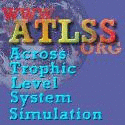



 |
 |
 |
 |
As part of the Comprehensive Everglades Restoration Plans (CERP),
a series of future water management regimes have been
proposed and simulated in the Everglades and Big Cypress
landscapes using the South Florida Water Management Model (SFWMM). The
Natural Systems Model (NSM) has been used to simulate
pre-management hydrologic conditions over the same model area. We have
used outputs from these hydrologic models to perform analyses using
ATLSS Spatially-Explicit Species Index (SESI) models, which provide
yearly analyses of the effects of hydrology on the availability of
breeding and/or foraging habitat for the species modeled across the
model area. We here discuss limitations to the conclusions
drawn from these simulations, relative to conclusions drawn from ATLSS
comparisons of other CERP scenarios.
The District hydrology models operate at the 2-mile scale of resolution
and produce water depth outputs at that scale. In previous ATLSS
comparative evaluations of hydrologic scenarios performed as part of
the Restudy, water has been redistributed to 500-m x 500-m pixels using
the ATLSS computer-generated high resolution topography map layer.
Generation of this map layer requires an accurate high-resolution
representation of vegetation for the relevant time period. For
evaluation of CERP SFWMM scenarios, ATLSS uses the representation provided
by the Florida Gap Analysis Vegetation Map (FGAP) version 2.1, which is
based on classification of 1992/1993 Landsat TM imagery. This is combined
with USGS HAED and Lidar data to produce a high resolution elevation
map. No vegetation map comparable to FGAP is available for the historical
period simulated by the NSM Hydrologic Model. For the NSM comparisons,
therefore, we do not redistribute water depths over a simulated
topography to achieve a higher scale of resolution. For purposes of
identification of habitat types, we utilize the FGAP vegetation map for
all scenarios.
Drainage and impoundment, and the subsequent development of urban areas
and intensive agriculture, have had profound impacts on Everglades
biota. Spatial extent of the Everglades has been reduced by half, and
the remaining areas have been affected by major alterations in
hydropattern. Analysis of hydroperiod maps
reveals the substantially larger extent of inundation under NSM,
extending northward over former sawgrass prairies now drained and
subsumed in the Everglades Agriculture Area, and eastward over natural
areas now converted to urban centers. Cycles of drought and flood have
been exacerbated, and timing and predictability of water flows have
been affected as well. Changes in soil, vegetation, and water quality, as
well as hydropattern alterations, have impacted breeding and foraging
potentials and population distributions. Invasions of exotic species,
changes in water temperature, dissolved oxygen, and nutrient loading,
increased human activity on the landscape, and a multitude of other
changes have accompanied water management.
The Natural Systems Model simulates hydropatterns before canals,
levees, dikes and pumps reshaped the landscape. The NSM reflects
frequency, duration, depth, and spatial extent of water inundation
under the natural system. To the extent that ATLSS index models are
hydrologically driven, we can compare NSM biotic impacts with those of
SFWMM scenarios within areas that remain in natural vegetation under
the SFWMM. However, each index model also has a habitat suitability
component that excludes pixels identified as habitat types that are
unsuitable for breeding of the modeled species (e.g., urban and
agricultural types).
Pixels that have been excluded based on their classification in the
FGAP vegetation map from SFWMM hydrology simulations must also be
excluded from NSM simulations. Although some of these areas would in
fact have provided suitable breeding habitat during the historical
period of the NSM, we have no way to assign historically correct
vegetation types without a vegetation map contemporaneous with NSM
hydrology. For this reason, we cannot capture the biological effects of
loss of spatial extent of breeding habitat under the managed system.
Therefore, in addition to other
sources of model uncertainty
for ATLSS Model outputs for the Initial CERP Update, the
NSM evaluations include limitations imposed by changes in habitat type
between the NSM modeling time period and that of the SFWMM.